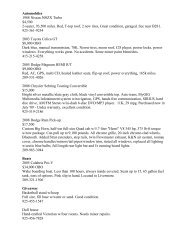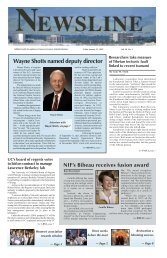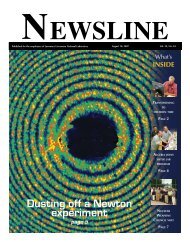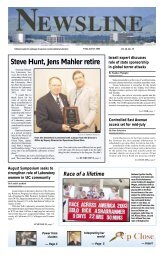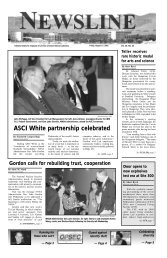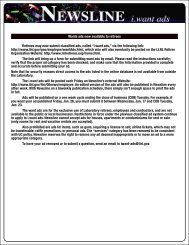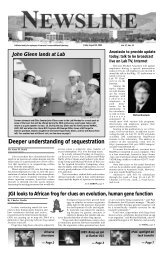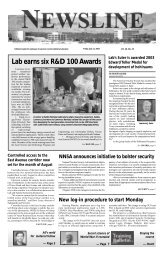JASPER gas gun - NEWSLINE - Lawrence Livermore National ...
JASPER gas gun - NEWSLINE - Lawrence Livermore National ...
JASPER gas gun - NEWSLINE - Lawrence Livermore National ...
You also want an ePaper? Increase the reach of your titles
YUMPU automatically turns print PDFs into web optimized ePapers that Google loves.
8 Newsline<br />
March 3, 2006<br />
Small mammals are ecological giants in local grasslands<br />
Despise or adore them, local burrowing<br />
mammals are receiving more<br />
attention as “big players” for their contribution<br />
to the overall well-being of<br />
California’s ecological communities.<br />
Ecological communities are defined<br />
as a group of interacting species living in<br />
the same place. A community is linked<br />
by the network of influences that species<br />
have on one another, great or small. One<br />
species may affect another one or<br />
numerous others in its ecological role.<br />
This concept has become popularized by<br />
the term, “the balance of nature,” and<br />
speaks to the complexity of levels of<br />
interaction that are occurring in any<br />
given community at any given time.<br />
Common yet a keystone species<br />
California ground squirrels<br />
(Spermophilus beecheyi) are being<br />
investigated as a “keystone species” for<br />
the California prairie ecosystem. This is<br />
a species whose presence or absence, or<br />
significant increase or decrease in population<br />
size, profoundly affects other<br />
species’ survivability in that habitat.<br />
Recognition of this ecological standing<br />
is usually derived from the results of<br />
studies in which the species is added or<br />
removed from the community.<br />
The term “keystone species” comes<br />
from the center stone in a Roman arch<br />
that supports the majority of the structure’s<br />
weight. Removal of this keystone<br />
causes the entire form to collapse. In this<br />
way, removal of a keystone species can<br />
lead to the local extirpation of many<br />
species and negative effects on the overall<br />
health of the ecosystem.<br />
Why are ground squirrels of<br />
heightened interest to ecologists?<br />
More than 200 other wildlife species<br />
have been sighted using ground squirrel<br />
colonies. Some species prey upon<br />
ground squirrels while others use their<br />
burrows for shelter. In Central<br />
California, common wildlife visitors<br />
to areas of ground squirrel occupation<br />
include red-tailed hawks, coyotes,<br />
golden eagles, northern Pacific rattlesnakes,<br />
and burrowing owls. Also,<br />
a long list of insects and plant species<br />
are associated with the<br />
colony’s construction area.<br />
Additionally, squirrel<br />
feeding activities result in a<br />
tilling or churning of the soil,<br />
enhancing its ability to support<br />
plants. A greater vegetative<br />
diversity – with nitrogenrich<br />
mixtures of grasses and<br />
forbs – offers sustenance to<br />
other animals. This enriched<br />
habitat attracts a wide array<br />
of grazers and browsers that<br />
wish to utilize these food<br />
resources. Ecologically heralded<br />
as the food web hierarchy,<br />
this diverse association<br />
of plants and wildlife is<br />
dependent on the squirrel’s<br />
presence for life.<br />
American badgers<br />
Another subterranean<br />
species that is gaining notoriety<br />
as an ecosystem giant in<br />
the California’s grassland<br />
prairie is the American badger<br />
(Taxidea taxus). Although<br />
not receiving the accolades of<br />
the keystone species, the badger is a<br />
close runner-up as an “ecosystem engineer.”<br />
This term denotes an organism<br />
that creates or modifies the physical<br />
environment in a significant way over<br />
time. Beavers (Castor canadensis) are<br />
the stereotypical ecosystem engineer<br />
because of the effects their dams have on<br />
stream flow, geomorphology, and the<br />
surrounding ecology and life forms that<br />
use the region.<br />
Badgers also do their share of native<br />
engineering by modifying the landscape<br />
and soil nutritive richness. By loosening<br />
and aerating the soil, they speed up the<br />
decomposition of vegetation, enhancing<br />
nutrient availability. During wildland<br />
fires, these soils can serve as firebreaks<br />
for down-hole escapees. Since badgers<br />
were part of the ecological setting before<br />
humans, they may ultimately be connected<br />
to the presence and restoration of<br />
native plant species and their seed banks.<br />
The large soil excavation mounds at the<br />
RON ARGANBRIGHT/MMED<br />
entrance of badger dens result<br />
in the mixing of nutrients and<br />
soil conditions as deep soil is<br />
brought to the surface.<br />
Badger burrows can act as<br />
homesteads to other wildlife<br />
species including rabbits,<br />
salamanders, frogs, snakes<br />
and long-tailed weasels, especially<br />
during the hot summer<br />
months. Badgers have been<br />
known to work “collaboratively”<br />
with hawks and coyotes<br />
to raid pocket gopher and squirrel<br />
holes (see inset photo).<br />
Regardless of the colorful scientific<br />
moniker used to identify these species<br />
and their ecological roles, current<br />
research suggests that these two<br />
California underground inhabitants play<br />
a bigger role in shaping the natural environment<br />
than was previously believed.<br />
Security Department to close Avenue B security post today<br />
The Lab’s Security Department has announced that security<br />
post 3B, on the north side of the intersection of Avenue B and<br />
Third Street, will close permanently beginning 6 p.m. today<br />
(March 3) —except for Fire Department emergency vehicle traffic.<br />
The closure is one of several cost-driven service reductions<br />
needed to meet the department’s FY 2006 budget reductions.<br />
Within approximately one block of pPost 3B, three alternate<br />
access points for use by pedestrians and bicyclists who<br />
must travel northbound or southbound in that area. The access<br />
booths are long enough to accommodate a bicycle and rider<br />
who has dismounted.<br />
Adjacent to each booth is either an electronic or manual<br />
turnstile for pedestrian access only. The electronic turnstile<br />
allows passage in either direction; the manual turnstile permits<br />
passage only from the Limited Area (LA) to the Property<br />
Protection Area (PPA). Employees who encounter problems<br />
with either the electronic access booths or turnstiles should call<br />
the PFD Alarms Console at 2-7222 to report malfunctions.<br />
The post 3B closure means that approved motor vehicles<br />
must use an alternate entry point when traveling between the<br />
LA and PPA. Alternate vehicle entry/exit points are security<br />
post 1D, at the east end of First Street, north of Blgd. 316; and<br />
post west fate (P-WG), at the west end of First Street, northwest<br />
of Bldg. 111. Post 1D is open all hours every day. P-WG<br />
is open 6:30 a.m.-6:30 p.m., Monday-Friday, and closed on<br />
weekends and holidays.<br />
NON-PROFIT ORG.<br />
U.S. POSTAGE<br />
PAID<br />
LIVERMORE, CA<br />
PERMIT NO. 154<br />
Newsline<br />
UC-LLNL<br />
PO Box 808, L-797<br />
<strong>Livermore</strong>, CA 94551-0808<br />
By Jim Woollett<br />
JIM WOOLLETT/EPD<br />
Badgers (left and below) are prairie ecosystem<br />
engineers. The ground squirrel (above) also plays<br />
an important role in the food web hierarchy.




